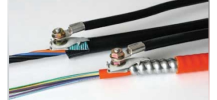As it relates to fibre there are many types of end connectors. Generally speaking, you would be using (LC) connectors.
Since you have limited space in the conduit your choice has already been decided for you unless you had the skill,
tools, and knowledge to split & join fibre.
In this case you would use a (Single Mode) LC (connector) Fibre with the same SM / LC BIDI transceiver. Essentially the BIDI transceiver transmits at two different wavelengths using a single cable vs a (MM) Multi Mode LC cable which has two separate cables joined together for RX / TX.
Grounding: As it relates to lightning protection / surge protection the key points.
- Low resistance (<25 Ohms) to Earth
- Single Point: Everything is bonded to the homes electrical grounding system.
- Wire: 6 - 12 AWG copper stranded / solid diameter wire based on the ampacity it’s expected to carry and codes in place.
As short as possible with no sharp bends in the cable. Depending upon the NEC / CEC codes in place the wire may be required to be bare copper vs insulated and coloured appropriately such as green / green yellow stripe.
Star Washer: This washer should be in place anytime a bolt / screw is used. This is the last line of defence to bite into the material and make solid contact as it relates to low resistance grounding on any metal surface.
Dielectric: This should be applied where needed to keep moisture at bay and help reduce corrosion, arcing, and insulation.
SPD: Surge Protective Device come in four (Types) and each are so rated to handle specific surge current and operate at different let through voltages. As such Type 1-3 should always be installed for layered protection. Type 4 should be in place if you want everything protected at the device level.
Type 1 is installed at the service entrance (Meter).
Type 2 is installed at the service panel (Breaker).
Type 3 is installed at the Point Of Use such as an outlet, surge strip, UPS, etc.
Type 4 is installed inline prior to any device like machinery, HVAC, Washer, etc.
Lightning Protection: There are three types / options available today. Proactive, Reactive, Hybrid systems that offer the most protection.
Proactive systems use electronics to generate positive / negative charged ions in the environment. Other mechanical systems use whiskers of wire to dissipate ions in the atmosphere.
Lightning rods are reactive and simply absorb the high voltage strike and shunt to ground the fault voltage through the wiring to earth ground.
These devices obviously only work if the lightning strikes the rod!
Lastly, there are thousands of so called stories about why something worked / didn’t. Bottom line it’s luck / no luck / to having everything perfectly in place.
There are millions of building that are struck by lightning every year and nothing ever happens after the fact. There are the same number of buildings where something always happens after the fact!
People also can not compare a communication tower made entirely of metal to a wooden building! Nor can you compare a metal building to one made out of concrete!






